|

|
Q*Password
Keeper |
QPasswordKeeper is an application for the Android platform. It stores a list
of passwords in an encrypted list. The list is encrypted using the AES
standard with a key length of 128 Bit. The list is stored in the
application internal memory.
Use Cases:
Aim of the application is to provide quick and easy access to a list of
password. The list is accessed through a single master password.
Features:
- Passwords are 128 Bit AES encrypted
- Backup of passwords in email, SD Card and Dropbox.
- Import password from SD Card and Dropbox (needs to be encrypted with the
current password)
- Secure password generator (configurable in application settings)
- Search password list by simply typing keywords
- Sort the list alphabetically or by category
- Edit passwords
- Java tool to decrypt ans list passwords
Application Screens:
| Password Screen |
|
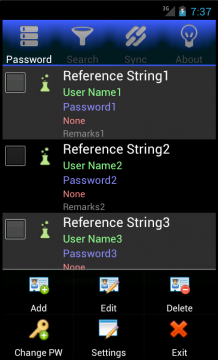
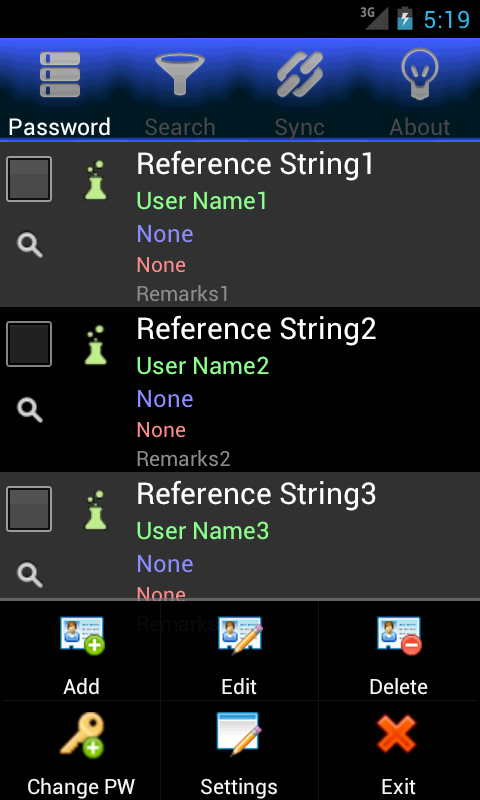
|
The password screen lists all passwords.
Each entry has the following parameters:
- a category represented through an icon
- a reference string that is used to identify the entry
- a user name (green)
- a password (blue)
If "show password" is disabled in the settings
screen a password hint is shown instead of the password.
- a URL associated with the entry (red)
- a remarks text (grey)
A long click on the password list opens the context menu. The list may
be sorted by the password parameters.
There is also an option to copy
the user name (green) to the clip board.
Another option allows the
password (blue) to be copied to the
clipboard.
Note: This feature has to be enabled in the
settings screen.
Attention: When enabled, the clear
text password is copied into the clipboard.
The password screen has two modes. If "Show passwords" is enabled the
passwords are shown for each entry. If disabled a password hint is shown
if available. The password is only revealed when pressing the magnifier
icon.
The following functions from the options menu are identical in both
modes of operation.
Press the menu button for the following options:
1) Add:
Pressing
this button launches another screen that allows for a new password to be
added.
2) Edit:
One and only one password has to be selected by setting the
tick box on the left side of the password row.
When the edit
button is pressed, the selected password entry is copied into a screen for
editing. Once the edit screen is left with an OK, the changes to the
password are stored and the application returns to the password
screen.
3) Delete:
The delete option deletes all password rows that have
been selected by ticking the box on the left hand side of the password
row.
Attention: Make sure you have selected only those
password rows that you want to delete.
4) Change PW:
Pressing this button opens a new screen to change the
master password. After pressing the "Set Master Password" button, the
password is encrypted and saved with the new
password.
Attention: The new master password
supersedes the old password and the password list is only accessible with
the new master password.
5) Settings:
Opens the settings dialog.
6) Exit:
This option will exit the application. |
| Search Screen |
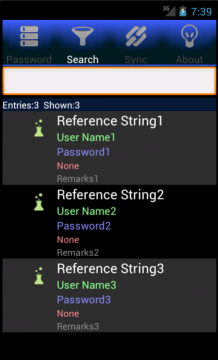 |
The search screen is the same as the password screen with the following
exceptions:
1) There is an additional search text field used to filter the password
list. Only those password entries are shown that contain text that matches
the text in the search text field.
2) The option dialog (menu button) and the context dialog (long
press) is not available. Change to the password screen in order to
access the option. |
| Edit Screen |
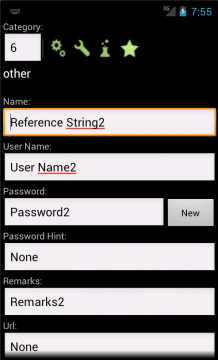 |
The edit screen allows all password parameters to be changed.
Select one of the predefined categories by either entering
the number of the category in the top left text field or by selecting
the corresponding icon.
Generate a new password by pressing the "new" button next to
Password.
Attention: The new password will overwrite
the existing password.
Change the text by touching a text field and change the
text.
Note: It is possible to use multiline
text. |
| Settings Screen |
|
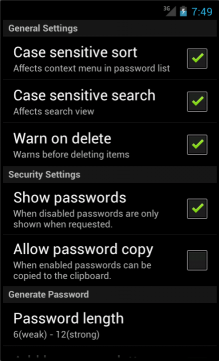
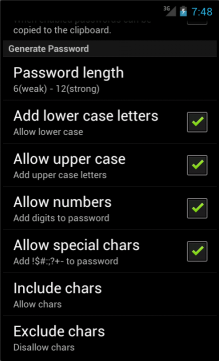
|
The settings screen allows the following adjustments:
1) Case sensitive sort
When enabled, the sort operations launched
through the context menu (long press) distinguish between upper and lower
case characters.
2) Case sensitive search
When enabled the search screen is case
sensitive, otherwise not.
3) Warn on delete
When enabled, a dialog is shown when attempting to
delete password entries.
4) Show passwords
When enabled, the cleartext passwords are shown in
the password list. When disabled, the passwords (blue) are not shown
("hidden" is shown instead). An additional icon is shown, which when
pressed, shows the clear text password in a pop-up window.
5) Allow password copy
When enabled, the password can be copied into
the clip board through the context menu.
6) Password settings
The passwords settings are applied when
generating a new password in the edit screen.
6.1) Password
length defines the number of characters used to generate the
password
6.2) "Add lower case" enabled will add lower case
characters to the generated password
6.3) "Allow upper case"
enabled will add upper case characters to the generated password
6.4) "Allow number" enabled will add digits to the generated
password
6.5) "Allow special" enabled will add special
characters (!$#:;?%+) to the generated password
6.6) "Include
chars" is a list of additionally characters allowed in the generated
password
6.7) "Exclude chars" is a list of characters not
allowed in the generated password
Attention: The
generated password is more secure when there is more variety allowed
to generate the password. The default settings are such to generate secure
passwords.
Note: You do not have to remember the
password. You just need to look it up in the
QPasswordKeeper.
|
| Synchronisation Screen |
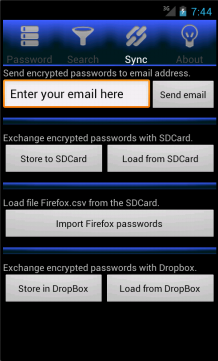 |
The Syncronise screen allows the encrypted passwords to be stored and
loaded externally.
There are three options available:
1) Send an email to your email address
containing the encrypted password list. Do so by entering your email
address in the top most text field. Then press the "Send email"
button. Depending on your phone setup you can choose the email
client to be used.
The email contains the password list,
which has been encrypted with your master password. The email body
contains this list.
2) The password list that has been
encypted with your master password is stored on the external SD Card when
pressing the "Store to external storage" button.
The file name is: /mnt/sdcard/download/QKeeperDoc.pbk
Pressing the "Load from external storage" button loads the above file,
tries to decrypt it with the current password and if sucessfull, replaces
the current passwords with the passwords within this
file.
Attention: The loading procedure overwrites
your current list.
Note: The external SD
Card has to be physically available and has to be mounted for this feature
to work. Otherwise an error message is shown.
The file on the SD Card can be copied onto a desktop client using tools
such as Kies.
Both the data transfer via email or the storage on the SD Card provide
means to move the encrypted list of passwords to an externally accessible
medium. |
Supporting Tools:
QKeeperDump is a Java console application that decrypts the password
list and dumps it to the screen.
Start the QKeeperDump from the command line using the
instruction below. The ">" is the command prompt and not part of the
instruction.
>java -jar QKeeperDump.jar
Usage: QKeeperMain <Input
Filename> <Password>
<Input Filename> is the name of the file containing the encrypted
password. This is the data that is exported via email
or by exporting the data to the external
memory.
<Password> is the password that was used to enrypt the
data on the phone.
Attention: The tool dumps a list of the passwords in clear
text.
QKeeperEditGui is a graphical viewer for the encrypted data. Also a Java
application. The application does not need to be installed. Store anywhere on
the computer and launch QKeeperEditGui via the
command line:
>java -jar QKeeperEditGui.jar
You may also add the line above in a batch file so that is becomes accessible
via single click from windows. Within the batch file make sure to cd to the
folder the application is stored prior to starting it.
Select the file name using the eclipse button, the open button or select
File->Open from the application menu. When prompted for the password enter
the master password also used in the Android app.
The list of password is filtered by the text entered in the filter toolbar
edit field. The filter is applied to all attributes in the list.
The URL is a hyperlink that follows to the URL when clicked.
Note: The application title is deceptive as it only allows
viewing the passwords. Editing may be supported in later versions.
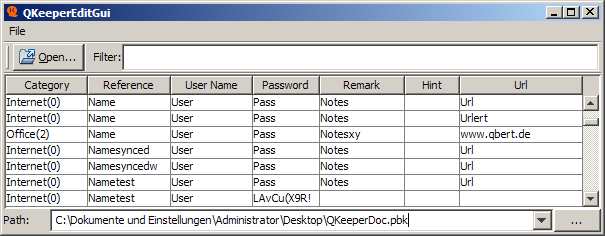
Attention: The tool displays the list of the passwords
in clear text.
This Web Page Created with PageBreeze Free HTML
Editor

